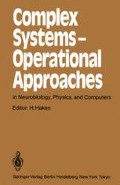Abstract
In this experiment we study the spatio-temporal behavior of an electron-hole (e-h) plasma. The plasma is produced by injecting both electrons and holes into a rod-shaped crystal of germanium at liquid nitrogen temperatures as shown in Fig. 1. The crystal is placed in a magnetic field parallel to its axis, and an adjustable electric field is also applied along the length of the sample. The plasma can absorb energy from the applied fields and, beyond some threshold (typically a few volts/cm at a few kilogauss), an unstable travelling helical density wave develops within the plasma, as shown in the Appendix, Fig. A-1. Several nonlinearly coupled modes can be excited within the boundaries of the crystal.
Access this chapter
Tax calculation will be finalised at checkout
Purchases are for personal use only
Preview
Unable to display preview. Download preview PDF.
References
For a review of chaotic behavior in physical systems, see H. L. Swinney:
Physica (Utrecht) 7D, 3 (1983).
See also general references, e.g., H. Haken: Advanced Synergetics (Springer-Verlag, Berlin, 1983);
John Guckenheimer and Philip Holmes: Nonlinear Oscillations, Dynamical Systems, and Bifurcations of Vector Fields (Springer-Verlag, New York, 1983).
D. Ruelle and F. Takens: Comm. Math. Phys. 20, 167 (1971);
J.-P. Eckmann: Rev. Mod. Phys. 53, 643 (1981);
E. Ott: Rev. Mod. Phys. 53, 655 (1981).
I. L. Ivanov and S. M. Ryvkin: Zh. Tekh. Fiz. 28, 774 (1958) [Sov. Phys. Tech. Phys. 3, 722 (1958)].
R. D. Larrabee and M. C. Steele: J. Appl. Phys. 31, 1519 (1960);
R. D. Larrabee: J. Appl. Phys. 34, 880 (1963);
J. Bok and R. Veilex: Compt. Rend. 248, 2300 (1958).
C. E. Hurwitz and A. L. McWhorter: Phys. Rev. 134, A1033 (1964).
M. Glicksman: Phys. Rev. 124, 1655 (1961);
M. Shulz: Phys. Status Solidi 25, 521 (1968).
G. A. Held, Carson Jeffries, and E. E. Haller: Phys. Rev. Lett. 52, 1037 (1984).
N. H. Packard, J. P. Crutchfield, J. D. Farmer, and R. S. Shaw: Phys. Rev. Lett. 45, 712 (1980).
See, for example, J. D. Farmer, E. Ott, and J. A. York: Physica (Utrecht) 7D, 153 (1983).
This is the method used by A. Brandstäter et al.: Phys. Rev. Lett. 51, 1442 (1983);
see Peter Grassberger and Itamar Procaccia: Phys. Rev. Lett. 50, 346 (1983).
For the embedding theorem to be applicable, it is required that D ≥ 2d+l, where D is the embedding dimension and d is the fractal dimension of the attractor; see Ref. 1.
See, e.g., J. P. Gollub and S. V. Benson in: Pattern Formation and Pattern Recognition, edited by H. Haken (Springer-Verlag, Berlin, 1979), p. 74.
T. Misawa and T. Yamada: Jpn. J. Appl. Phys. 2, 19 (1963).
H. S. Greenside, A. Wolf, J. Swift, and T. Pignataro: Phys. Rev. A 25, 3453 (1982).
R. Z. Sagdeev and A. A. Galeev: Nonlinear Plasma Theory (Benjamin, New York, 1969).
J.-M. Wersinger, J. M. Finn, and E. Ott: Phys. Fluids 23, 1142 (1980).
F. C. Hoh and B. Lehnert: Phys. Rev. Lett. 7, 75 (1961).
Author information
Authors and Affiliations
Editor information
Editors and Affiliations
Rights and permissions
Copyright information
© 1985 Springer-Verlag Berlin Heidelberg
About this paper
Cite this paper
Held, G.A., Jeffries, C.D. (1985). Chaos and Turbulence in an Electron-Hole Plasma in Germanium. In: Haken, H. (eds) Complex Systems — Operational Approaches in Neurobiology, Physics, and Computers. Springer Series in Synergetics, vol 31. Springer, Berlin, Heidelberg. https://doi.org/10.1007/978-3-642-70795-7_24
Download citation
DOI: https://doi.org/10.1007/978-3-642-70795-7_24
Publisher Name: Springer, Berlin, Heidelberg
Print ISBN: 978-3-642-70797-1
Online ISBN: 978-3-642-70795-7
eBook Packages: Springer Book Archive

